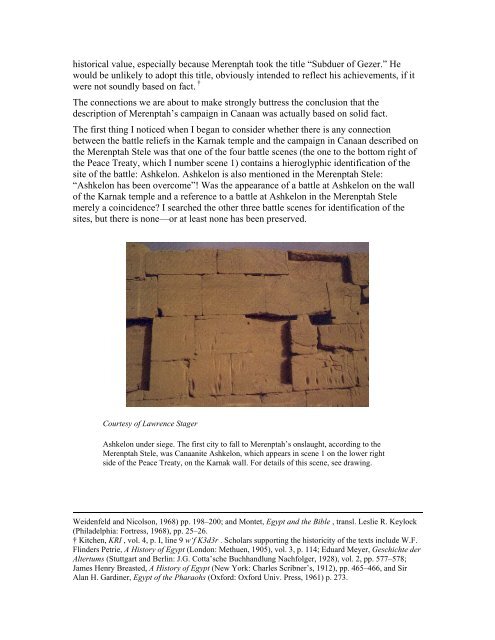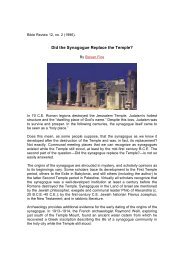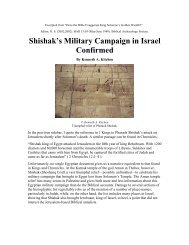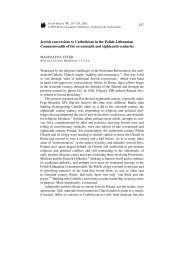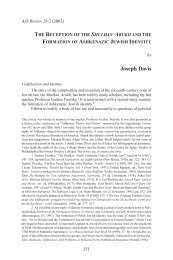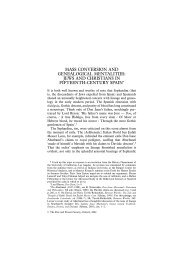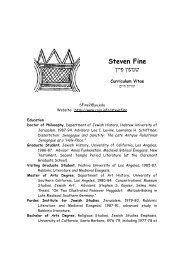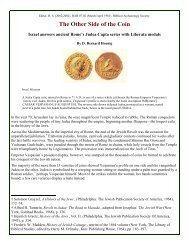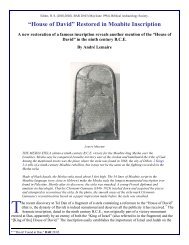3200-Year-Old Picture of Israelites Found in Egypt
3200-Year-Old Picture of Israelites Found in Egypt
3200-Year-Old Picture of Israelites Found in Egypt
You also want an ePaper? Increase the reach of your titles
YUMPU automatically turns print PDFs into web optimized ePapers that Google loves.
historical value, especially because Merenptah took the title “Subduer <strong>of</strong> Gezer.” He<br />
would be unlikely to adopt this title, obviously <strong>in</strong>tended to reflect his achievements, if it<br />
were not soundly based on fact. †<br />
The connections we are about to make strongly buttress the conclusion that the<br />
description <strong>of</strong> Merenptah’s campaign <strong>in</strong> Canaan was actually based on solid fact.<br />
The first th<strong>in</strong>g I noticed when I began to consider whether there is any connection<br />
between the battle reliefs <strong>in</strong> the Karnak temple and the campaign <strong>in</strong> Canaan described on<br />
the Merenptah Stele was that one <strong>of</strong> the four battle scenes (the one to the bottom right <strong>of</strong><br />
the Peace Treaty, which I number scene 1) conta<strong>in</strong>s a hieroglyphic identification <strong>of</strong> the<br />
site <strong>of</strong> the battle: Ashkelon. Ashkelon is also mentioned <strong>in</strong> the Merenptah Stele:<br />
“Ashkelon has been overcome”! Was the appearance <strong>of</strong> a battle at Ashkelon on the wall<br />
<strong>of</strong> the Karnak temple and a reference to a battle at Ashkelon <strong>in</strong> the Merenptah Stele<br />
merely a co<strong>in</strong>cidence? I searched the other three battle scenes for identification <strong>of</strong> the<br />
sites, but there is none—or at least none has been preserved.<br />
Courtesy <strong>of</strong> Lawrence Stager<br />
Ashkelon under siege. The first city to fall to Merenptah’s onslaught, accord<strong>in</strong>g to the<br />
Merenptah Stele, was Canaanite Ashkelon, which appears <strong>in</strong> scene 1 on the lower right<br />
side <strong>of</strong> the Peace Treaty, on the Karnak wall. For details <strong>of</strong> this scene, see draw<strong>in</strong>g.<br />
Weidenfeld and Nicolson, 1968) pp. 198–200; and Montet, <strong>Egypt</strong> and the Bible , transl. Leslie R. Keylock<br />
(Philadelphia: Fortress, 1968), pp. 25–26.<br />
† Kitchen, KRI , vol. 4, p. I, l<strong>in</strong>e 9 w‘f K3d3r . Scholars support<strong>in</strong>g the historicity <strong>of</strong> the texts <strong>in</strong>clude W.F.<br />
Fl<strong>in</strong>ders Petrie, A History <strong>of</strong> <strong>Egypt</strong> (London: Methuen, 1905), vol. 3, p. 114; Eduard Meyer, Geschichte der<br />
Altertums (Stuttgart and Berl<strong>in</strong>: J.G. Cotta’sche Buchhandlung Nachfolger, 1928), vol. 2, pp. 577–578;<br />
James Henry Breasted, A History <strong>of</strong> <strong>Egypt</strong> (New York: Charles Scribner’s, 1912), pp. 465–466, and Sir<br />
Alan H. Gard<strong>in</strong>er, <strong>Egypt</strong> <strong>of</strong> the Pharaohs (Oxford: Oxford Univ. Press, 1961) p. 273.


